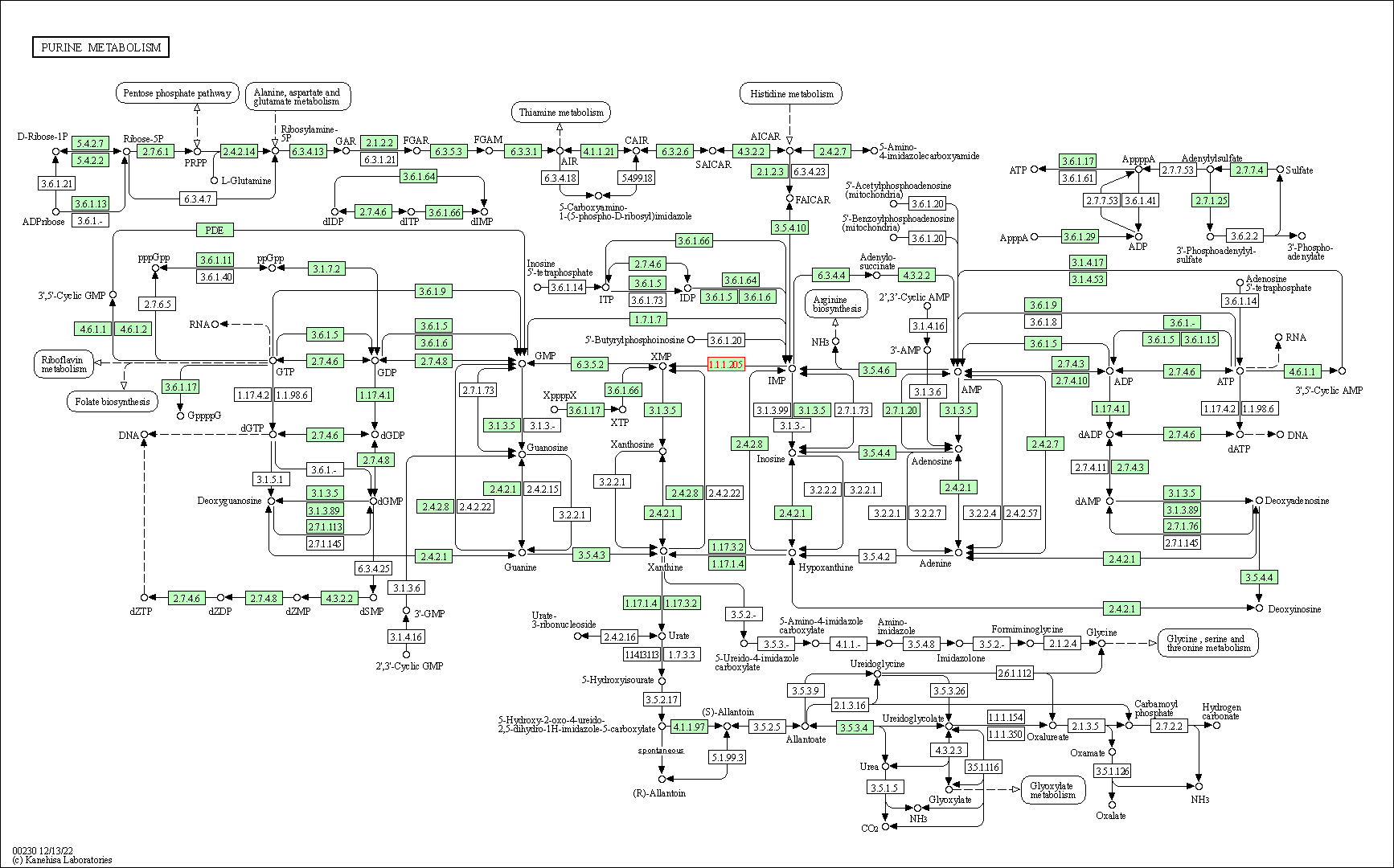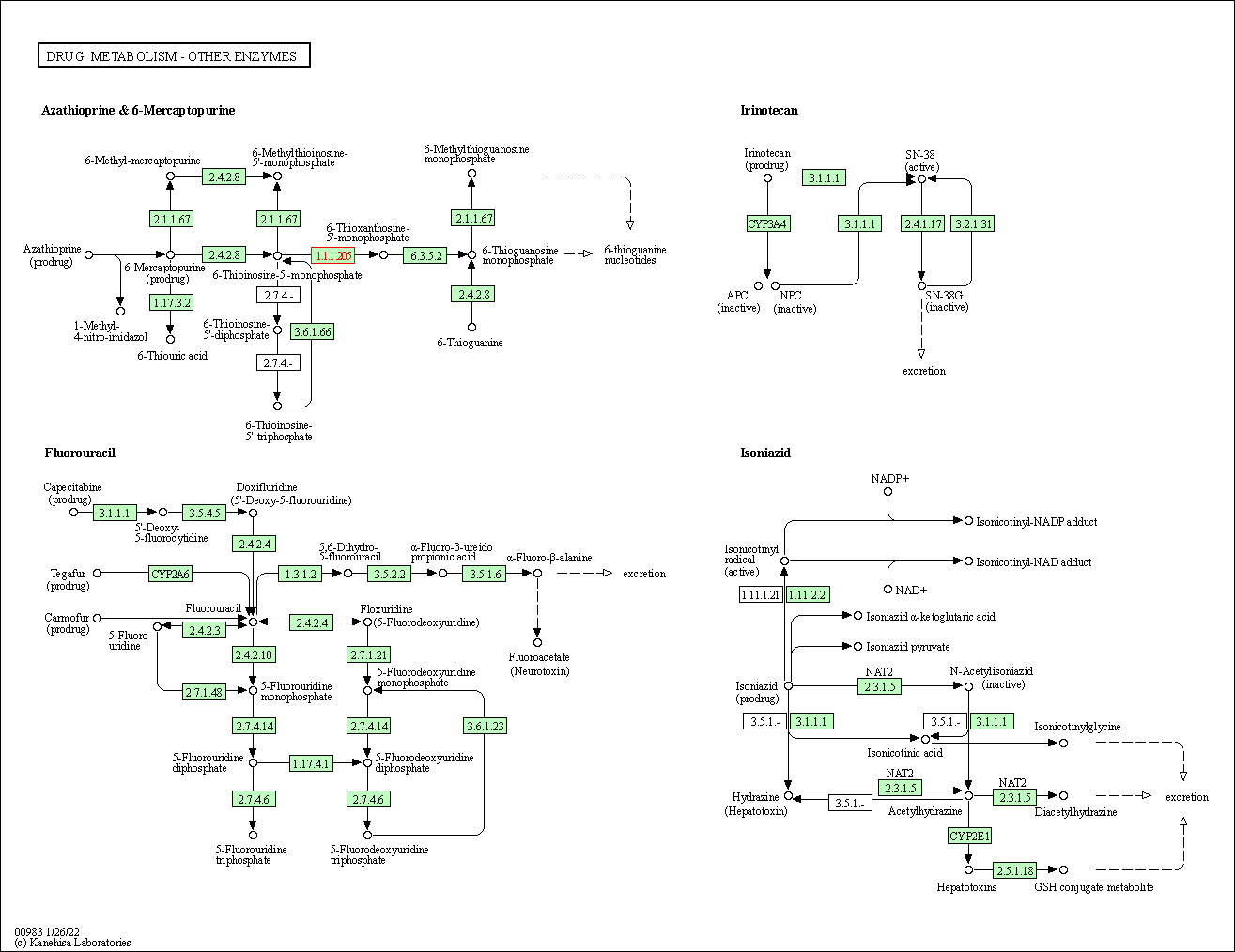Target Information
| Target General Information | Top | |||||
|---|---|---|---|---|---|---|
| Target ID |
T86573
|
|||||
| Target Name |
HUMAN inosine-5'-monophosphate dehydrogenase 2 (IMPDH2)
|
|||||
| Synonyms |
IMPDH-II; IMPDH 2; IMPD2; IMPD 2; IMP dehydrogenase 2
Click to Show/Hide
|
|||||
| Gene Name |
IMPDH2
|
|||||
| Disease | [+] 1 Target-related Diseases | + | ||||
| 1 | Hepatitis virus infection [ICD-11: 1E50-1E51] | |||||
| Function |
Could also have a single-stranded nucleic acid-binding activity and could play a role in RNA and/or DNA metabolism. It may also have a role in the development of malignancy and the growth progression of some tumors. Catalyzes the conversion of inosine 5'-phosphate (IMP) to xanthosine 5'-phosphate (XMP), the first committed and rate-limiting step in the de novo synthesis of guanine nucleotides, and therefore plays an important role in the regulation of cell growth.
Click to Show/Hide
|
|||||
| BioChemical Class |
CH-OH donor oxidoreductase
|
|||||
| UniProt ID | ||||||
| EC Number |
EC 1.1.1.205
|
|||||
| Sequence |
MADYLISGGTSYVPDDGLTAQQLFNCGDGLTYNDFLILPGYIDFTADQVDLTSALTKKIT
LKTPLVSSPMDTVTEAGMAIAMALTGGIGFIHHNCTPEFQANEVRKVKKYEQGFITDPVV LSPKDRVRDVFEAKARHGFCGIPITDTGRMGSRLVGIISSRDIDFLKEEEHDCFLEEIMT KREDLVVAPAGITLKEANEILQRSKKGKLPIVNEDDELVAIIARTDLKKNRDYPLASKDA KKQLLCGAAIGTHEDDKYRLDLLAQAGVDVVVLDSSQGNSIFQINMIKYIKDKYPNLQVI GGNVVTAAQAKNLIDAGVDALRVGMGSGSICITQEVLACGRPQATAVYKVSEYARRFGVP VIADGGIQNVGHIAKALALGASTVMMGSLLAATTEAPGEYFFSDGIRLKKYRGMGSLDAM DKHLSSQNRYFSEADKIKVAQGVSGAVQDKGSIHKFVPYLIAGIQHSCQDIGAKSLTQVR AMMYSGELKFEKRTSSAQVEGGVHSLHSYEKRLF Click to Show/Hide
|
|||||
| 3D Structure | Click to Show 3D Structure of This Target | PDB | ||||
| Drugs and Modes of Action | Top | |||||
|---|---|---|---|---|---|---|
| Drugs in Phase 1 Trial | [+] 1 | + | ||||
| 1 | Ribavirin | Drug Info | Approved | Hepatitis C virus infection | [2] | |
| Investigative Agents | [+] 1 | + | ||||
| 1 | Merimepodib | Drug Info | Phase 2b | Hepatitis C virus infection | [3] | |
| Mode of Action | [+] 1 Modes of Action | + | ||||
| Inhibitor | [+] 2 Inhibitor drugs | + | ||||
| 1 | Ribavirin | Drug Info | [4] | |||
| 2 | Merimepodib | Drug Info | [1] | |||
| Cell-based Target Expression Variations | Top | |||||
|---|---|---|---|---|---|---|
| Cell-based Target Expression Variations | ||||||
| Drug Binding Sites of Target | Top | |||||
|---|---|---|---|---|---|---|
| Ligand Name: Adenosine triphosphate | Ligand Info | |||||
| Structure Description | Human IMPDH2 treated with ATP, IMP, and 20 mM GTP. Fully compressed filament segment reconstruction. | PDB:6UDO | ||||
| Method | Electron microscopy | Resolution | 3.21 Å | Mutation | No | [5] |
| PDB Sequence |
YVPDDGLTAQ
21 QLFNCGDGLT31 YNDFLILPGY41 IDFTADQVDL51 TSALTKKITL61 KTPLVSSPMD 71 TVTEAGMAIA81 MALTGGIGFI91 HHNCTPEFQA101 NEVRKVKKYE111 QGFITDPVVL 121 SPKDRVRDVF131 EAKARHGFCG141 IPITDTGRMG151 SRLVGIISSR161 DIDFLKEEEH 171 DCFLEEIMTK181 REDLVVAPAG191 ITLKEANEIL201 QRSKKGKLPI211 VNEDDELVAI 221 IARTDLKKNR231 DYPLASKDAK241 KQLLCGAAIG251 THEDDKYRLD261 LLAQAGVDVV 271 VLDSSQGNSI281 FQINMIKYIK291 DKYPNLQVIG301 GNVVTAAQAK311 NLIDAGVDAL 321 RVGMGSGSIC331 ITQEVLACGR341 PQATAVYKVS351 EYARRFGVPV361 IADGGIQNVG 371 HIAKALALGA381 STVMMGSLLA391 ATTEAPGEYF401 FSDGIRLKKY411 RGMGSLDAMI 437 KVAQGVSGAV447 QDKGSIHKFV457 PYLIAGIQHS467 CQDIGAKSLT477 QVRAMMYSGE 487 LKFEKRTSSA497 QVEGGVHSLH507 SYEKRLF
|
|||||
|
|
||||||
| Click to View More Binding Site Information of This Target and Ligand Pair | ||||||
| Ligand Name: C2-MAD | Ligand Info | |||||
| Structure Description | Ternary complex of the human type II Inosine Monophosphate Dedhydrogenase with Ribavirin Monophosphate and C2-Mycophenolic Adenine Dinucleotide | PDB:1NF7 | ||||
| Method | X-ray diffraction | Resolution | 2.65 Å | Mutation | No | [6] |
| PDB Sequence |
TSYVPDDGLT
19 AQQLFNCGDG29 LTYNDFLILP39 GYIDFTADQV49 DLTSALTKKI59 TLKTPLVSSP 69 MDTVTEAGMA79 IAMALTGGIG89 FIHHNCTPEF99 QANEVRKVKK109 YEQGFITDPV 119 VLSPKGIISS160 RDIDFLEHDC173 FLEEIMTKRE183 DLVVAPAGIT193 LKEANEILQR 203 SKKGKLPIVN213 EDDELVAIIA223 RTLKKNRDYP234 LASKDAKKQL244 LCGAAIGTHE 254 DDKYRLDLLA264 QAGVDVVVLD274 SSQGNSIFQI284 NMIKYIKDKY294 PNLQVIGGNV 304 VTAAQAKNLI314 DAGVDALRVG324 MGSGSICITQ334 EVLACGRPQA344 TAVYKVSEYA 354 RRFGVPVIAD364 GGIQNVGHIA374 KALALGASTV384 MMGSLLAATT394 EAPGEYFFSD 404 GIRLKKYRGM414 GSLDAMIKVA440 QGVSGAVQDK450 GSIHKFVPYL460 IAGIQHSCQD 470 IGAKSLTQVR480 AMMYSGELKF490 EKRTSSAQVE500 GGVHSLHSYE510 KRLF |
|||||
|
|
||||||
| Click to View More Binding Site Information of This Target with Different Ligands | ||||||
| Different Human System Profiles of Target | Top |
|---|---|
|
Human Similarity Proteins
of target is determined by comparing the sequence similarity of all human proteins with the target based on BLAST. The similarity proteins for a target are defined as the proteins with E-value < 0.005 and outside the protein families of the target.
A target that has fewer human similarity proteins outside its family is commonly regarded to possess a greater capacity to avoid undesired interactions and thus increase the possibility of finding successful drugs
(Brief Bioinform, 21: 649-662, 2020).
Human Tissue Distribution
of target is determined from a proteomics study that quantified more than 12,000 genes across 32 normal human tissues. Tissue Specificity (TS) score was used to define the enrichment of target across tissues.
The distribution of targets among different tissues or organs need to be taken into consideration when assessing the target druggability, as it is generally accepted that the wider the target distribution, the greater the concern over potential adverse effects
(Nat Rev Drug Discov, 20: 64-81, 2021).
Human Pathway Affiliation
of target is determined by the life-essential pathways provided on KEGG database. The target-affiliated pathways were defined based on the following two criteria (a) the pathways of the studied target should be life-essential for both healthy individuals and patients, and (b) the studied target should occupy an upstream position in the pathways and therefore had the ability to regulate biological function.
Targets involved in a fewer pathways have greater likelihood to be successfully developed, while those associated with more human pathways increase the chance of undesirable interferences with other human processes
(Pharmacol Rev, 58: 259-279, 2006).
Biological Network Descriptors
of target is determined based on a human protein-protein interactions (PPI) network consisting of 9,309 proteins and 52,713 PPIs, which were with a high confidence score of ≥ 0.95 collected from STRING database.
The network properties of targets based on protein-protein interactions (PPIs) have been widely adopted for the assessment of target’s druggability. Proteins with high node degree tend to have a high impact on network function through multiple interactions, while proteins with high betweenness centrality are regarded to be central for communication in interaction networks and regulate the flow of signaling information
(Front Pharmacol, 9, 1245, 2018;
Curr Opin Struct Biol. 44:134-142, 2017).
Human Similarity Proteins
Human Tissue Distribution
Human Pathway Affiliation
Biological Network Descriptors
|
|
|
There is no similarity protein (E value < 0.005) for this target
|
|
Note:
If a protein has TS (tissue specficity) scores at least in one tissue >= 2.5, this protein is called tissue-enriched (including tissue-enriched-but-not-specific and tissue-specific). In the plots, the vertical lines are at thresholds 2.5 and 4.
|
| KEGG Pathway | Pathway ID | Affiliated Target | Pathway Map |
|---|---|---|---|
| Purine metabolism | hsa00230 | Affiliated Target |

|
| Class: Metabolism => Nucleotide metabolism | Pathway Hierarchy | ||
| Drug metabolism - other enzymes | hsa00983 | Affiliated Target |

|
| Class: Metabolism => Xenobiotics biodegradation and metabolism | Pathway Hierarchy | ||
| Degree | 7 | Degree centrality | 7.52E-04 | Betweenness centrality | 5.39E-05 |
|---|---|---|---|---|---|
| Closeness centrality | 1.69E-01 | Radiality | 1.27E+01 | Clustering coefficient | 2.86E-01 |
| Neighborhood connectivity | 9.43E+00 | Topological coefficient | 2.73E-01 | Eccentricity | 12 |
| Download | Click to Download the Full PPI Network of This Target | ||||
| Chemical Structure based Activity Landscape of Target | Top |
|---|---|
| Target Poor or Non Binders | Top | |||||
|---|---|---|---|---|---|---|
| Target Poor or Non Binders | ||||||
| References | Top | |||||
|---|---|---|---|---|---|---|
| REF 1 | The IMPDH inhibitor merimepodib suppresses SARS-CoV-2 replication in vitro. April 09, 2020. doi: https://doi.org/10.1101/2020.04.07.028589 | |||||
| REF 2 | Drugs@FDA. U.S. Food and Drug Administration. U.S. Department of Health & Human Services. 2015 | |||||
| REF 3 | Merimepodib, Pegylated Interferon, and Ribavirin in Genotype 1 Chronic Hepatitis C Pegylated Interferon and Ribavirin Nonresponders. Hepatology. 2009 Dec;50(6):1719-26. | |||||
| REF 4 | Proteomics of SARS-CoV-2-infected Host Cells Reveals Therapy Targets. Nature. 2020 May 14. doi: 10.1038/s41586-020-2332-7. | |||||
| REF 5 | Cryo-EM structures demonstrate human IMPDH2 filament assembly tunes allosteric regulation. Elife. 2020 Jan 30;9:e53243. | |||||
| REF 6 | Crystal Structure of Human Inosine Monophosphate Dehydrogenase type II complexed with the MPA/NAD analog C2-MAD | |||||
If You Find Any Error in Data or Bug in Web Service, Please Kindly Report It to Dr. Zhou and Dr. Zhang.

